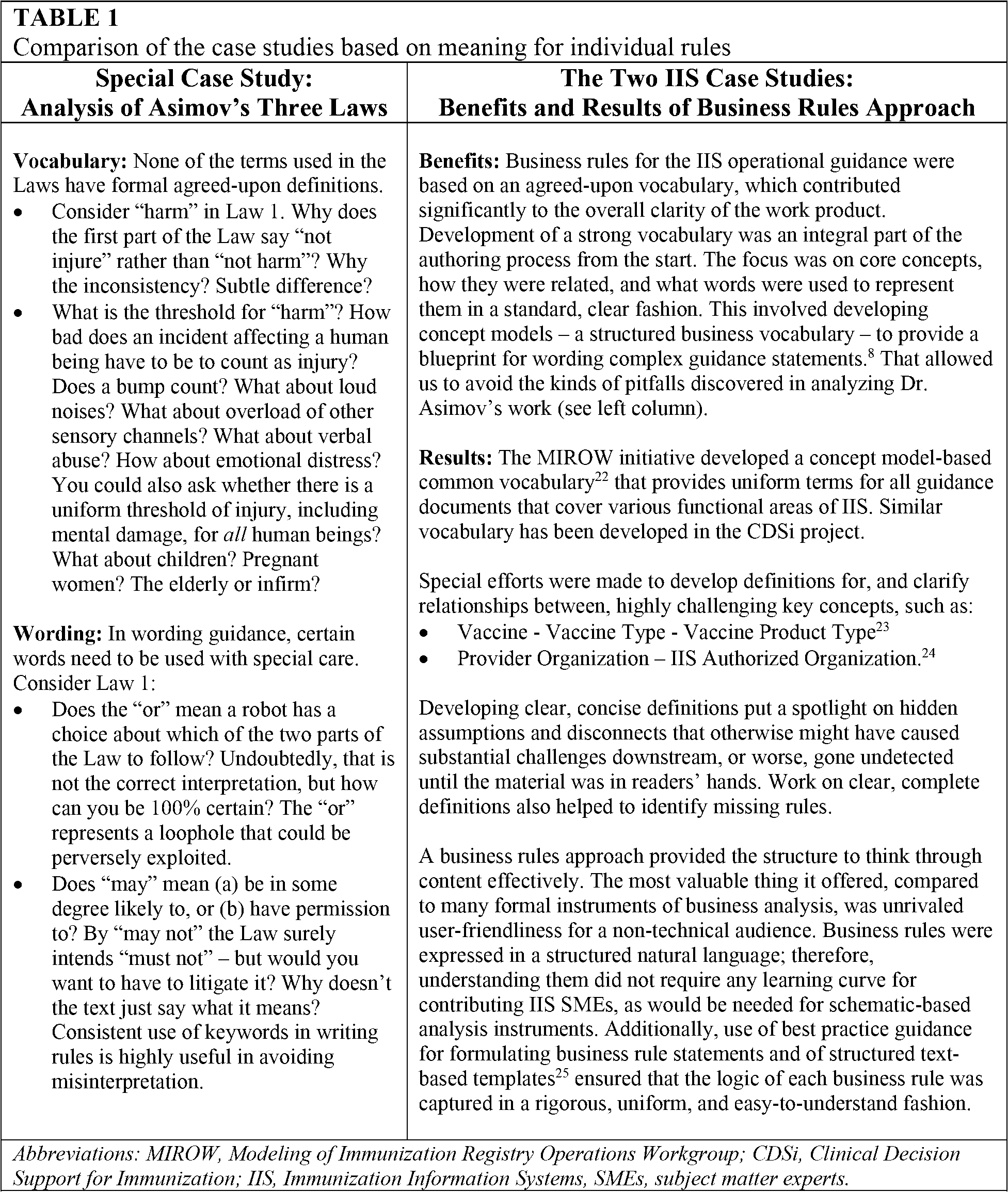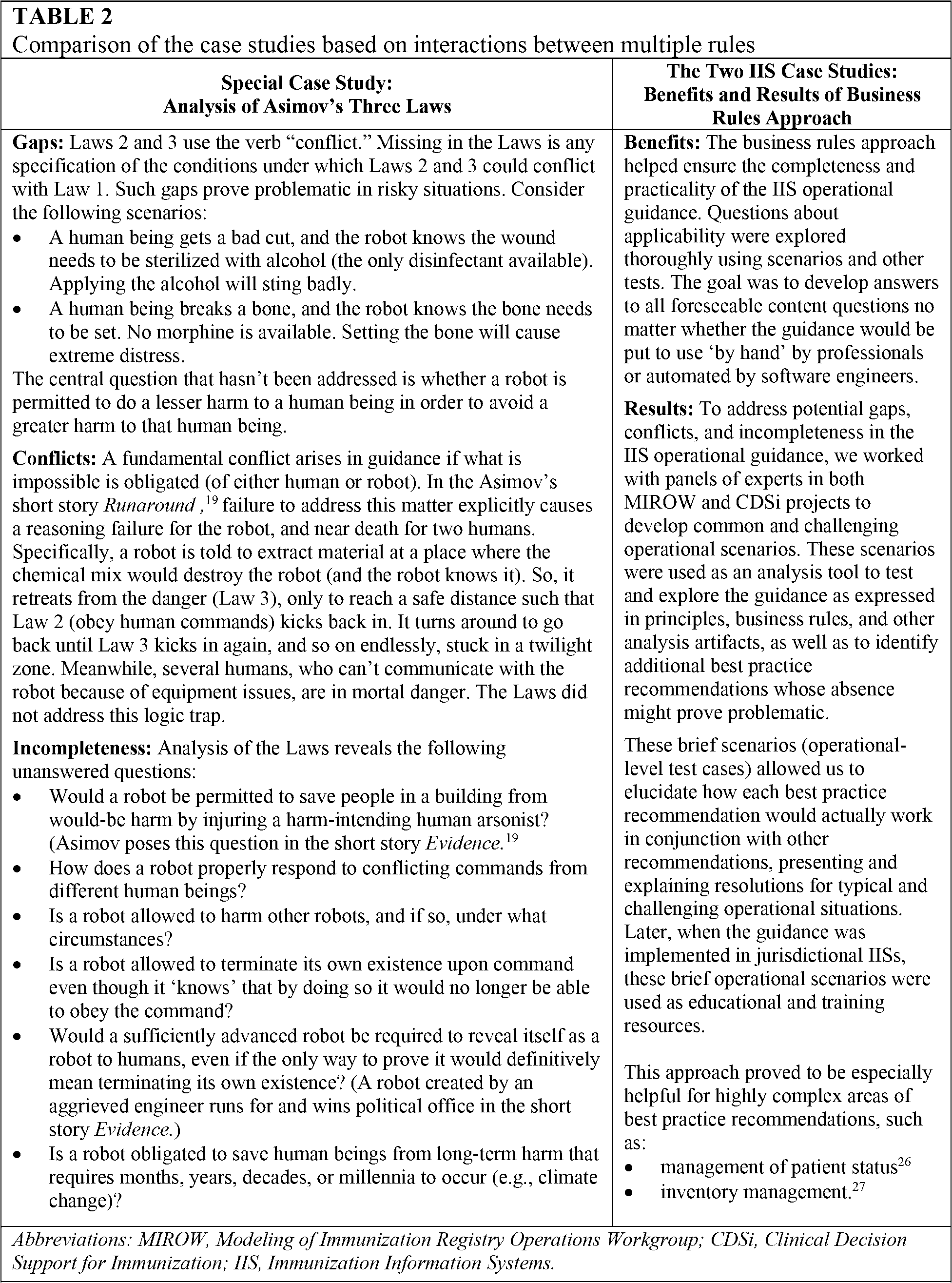Improving the Quality of Public Health Guidance: A Business Rules Approach
The two successful case studies in the IIS domain of public health point to the potential of applying business rules methods in rigorously documenting operational guidance, substantially reducing ambiguity, and ultimately, improving the uniformity, completeness, and practicality of information within critical documents of public health programs. Experience gained with these projects can be leveraged and built upon going forward. Also, a special study of writings by Dr. Asimov provides a strong word of caution about the unintended consequences and potential shortcomings of formulating guidance without leveraging a systematic approach, such as offered by business rules techniques.
Author Affiliations: Centers for Disease Control and Prevention, National Center for Immunization and Respiratory Diseases, Immunization Services Division, Informatics and Data Analytics Branch (formerly Immunization Information Systems Support Branch) (Drs D Lyalin and S Myerburg), Atlanta, GA; and Business Rule Solutions, LLC and Business Rules Journal (Mr. RG Ross), Houston, TX.
Disclaimer: The findings and conclusions in this article are those of the authors and do not necessarily represent the official position of the Centers for Disease Control and Prevention.
Acknowledgements: The authors would like to express gratitude for the stimulating work of the late scientist and writer Dr. Isaac Asimov. His groundbreaking formulation of The Three Laws of Robotics and his exploration of these laws in masterfully crafted imaginary scenarios, was inspiring and educational, demonstrating the great value that storytelling techniques can bring to business analysis. Dr. Asimov also recognized the importance of establishing laws and rules for behavior, making him an early pioneer in what we now know as the business rules discipline. We critique his work in this article only because we have had an advantage of many decades to learn from and build on his work.
"It is the obvious which is so difficult to see most of the time. People say:
'It's as plain as the nose on your face.' But how much of the nose on your face
can you see unless someone holds a mirror up to you?"
— Isaac Asimov
Introduction and Background
In this article, we discuss potential advantages that business rules methodology offers for improvement of public health operational guidance and documents*.
Public health in the United States is organized as a federated enterprise that encompasses federal, state, and local programs. In a typical setup, a federal (national) level public health program provides supplemental funds to state and local programs, targeting accomplishment of national priorities. This funding is complemented with operational guidance aimed at ensuring the effectiveness of awardees' programs, uniformity of their operations, and ultimately, comparability and quality of data that they provide for the nationwide analysis and decision making. Readability, clarity, and user friendliness of the documents that deliver the guidance are critical for funding recipients to correctly interpret the information.
The importance of creating effective, high-quality guidance for public health programs has been well understood, and concerted efforts go into their creation. The guidance documents are developed by leading public health scientists and expert practitioners, in close collaboration with communication specialists. The development process is detailed in the CDC standard operational procedures (SOP) for development of guidance.1 It involves elaborate steps that may include internal reviews, as well as inputs from community partners. As a result of such concerted efforts, these operational guidance documents are considered to be suitable for the purpose for which they were intended.
Still, there is always a need for ongoing improvement of these documents, enhancement of their expressiveness and rigor, and substantial reduction in remaining ambiguities and possibilities for misinterpretation. That need is quite important and has been recently emphasized in the CDC Moving Forward strategic initiative: "Translate science into practical, easy-to-understand policy. We must take our concrete lessons learned from COVID-19 to improve how we deliver our science, guidance, and programs to the American people."2
Systematic methods of business analysis, such as business rules techniques, have proven a highly effective way across industries to document and present critical business knowledge, as well as develop practical, sound, and complete domain logic that can be implemented in a consistent way.
Suitability and capabilities of business analysis techniques to unambiguously describe intricacies of guidance were well understood and formulated by public health thought leaders, such as Dr. O'Carroll, Dr. Yasnoff, and others3: "Engineering techniques of business analysis should be applied to understand the business of public health — to elucidate in concrete terms exactly what the public health agency [program] does. This step, seemingly straightforward, can in fact be the most difficult and time-consuming element. It involves the development of models of the business by use of formal modeling techniques."
Even today, twenty years later, the authors are not aware of many examples where systematic methods of the business analysis discipline4,5 — especially business rules techniques6-10 that offer opportunities for bringing crucially important programmatic documentation to the next level of clarity, completeness, and rigor — are employed for the development process of public health guidance.
In this article, we use results from two successful multi-year initiatives conducted at the Immunization Information Systems (IIS) Support Branch11 at CDC, as well as a special case study of writings by Dr. Isaac Asimov, prominent scientist, professor of biochemistry, and legendary science-fiction writer, to illustrate and discuss what a business rules methodology offers for advancing the quality of public health guidance and documents.
Projects Serving as Case Studies for the IIS domain
Systematic methods of business analysis and business rules techniques were successfully employed at the IIS Support Branch at CDC in the following two multi-year efforts of developing guidance for various aspects of IIS operations.
IIS Domain Case 1
The Modeling of Immunization Registry Operations Workgroup (MIROW)12,13 was formed in 2005 in partnership with the American Immunization Registry Association (AIRA) to develop best practice operational guidance for IISs. Today, the group continues to develop and update best practices guidance documents that provide a basis for aligning IIS operations and processes with recommended guidance in order to promote uniformity among IISs, and ultimately, consistency and comparability of immunization data. Best practice recommendations offer practical guidance on the most challenging operational areas, such as data quality assurance, reminder/recall for due or overdue vaccines, deduplication of immunization records, patients' eligibility for public immunization programs, vaccine inventory management, business continuity, and immunization coverage assessments. Multiple business analysis techniques have been used to identify and capture best practice recommendations. For example:
- Concept modeling6,8,14 provided a common vocabulary and established a foundation for other model types.
- Decision models, such as business rules6-10 and decision tables15, were utilized to unambiguously develop and document guidance for operational-level decision-making.
- Process models4,5, such as use cases (structured description of operational scenarios) and a variety of process diagrams, were employed to describe processes and process participants.
- State-event models4,5 assisted in analysis of events that lead to change of statuses for various public health concepts (e.g., status of a vaccine dose during its life cycle).
These techniques were instrumental for providing rigor and structure in identifying operational challenges, formulating solutions consensus across a diverse audience, and documenting guidance in a clear, unambiguous manner.
Independent evaluation findings16 indicate that application of these best practice recommendations in the IIS domain of state and local health departments resulted in improved data quality, reduced staff time, and increased efficiencies across immunization programs. Vendors are also using this guidance as a reference source to implement operational best practices on a variety of IT platforms.
IIS Domain Case 2
Another successful project, Clinical Decision Support for Immunization (CDSi), was established in 2010 at the IIS Support Branch at CDC and employs business analysis and business rule techniques for evaluation and forecasting in clinical decision support (CDS) for immunizations.17
Authoritative immunization recommendations are developed by the Advisory Committee on Immunization Practices (ACIP). After ACIP recommendations are published, technical and clinical subject matter experts (SMEs) work to interpret and integrate them into their CDS engines. A CDS engine is an automated system that determines the recommended immunizations needed for a patient and delivers the ACIP recommendations to the healthcare provider. Interpretation and translation of this guidance from clinical language into technical logic for each CDS engine was historically time-consuming and complex and done mostly independently for each system. As a result, CDS engine outputs often varied and did not always match the expectations of clinical SMEs.
Use of business analysis and business rules techniques allowed interpretation and capture of ACIP recommendations in an unambiguous, complete, and ready-to-apply manner. The result was uniform representation of vaccine decision guidance, as well as the ability to automate vaccine evaluation and forecasting consistently.18
As a result, CDSi provides a single, reliable, implementation-neutral foundation for development and maintenance of CDS engines. The rigorous analysis models provide a bridge between the clinical recommendations and the technical logic needed for a CDS engine. Business rules techniques provide uniformity and reduce ambiguity, assuring patients receive the right immunization at the right time.18
Throughout the COVID-19 pandemic, the CDSi team at CDC was able to correctly interpret, rapidly update, and publish the evolving vaccine scheduling recommendations by leveraging the framework established through business analysis and business rules.
Special Case Study: The Three Laws of Robotics
In this special case study, we demonstrate that even fine text-based writings, widely recognized and praised over the years, can have substantial shortcomings, although constructed quite logically based on formulated rules. These shortcomings include significant ambiguity, wide potential for misinterpretation, and very risky incompleteness. The study is based on the work of Dr. Isaac Asimov who, in the 1942 short story "Runaround"19, formulated a set of rules, known as the Three Laws of Robotics. Even today, eighty years later, these iconic rules enjoy a broad admiration and following not only among science fiction enthusiasts, but, most importantly, among government, academic, and business officials concerned with implications arising from advances in artificial intelligence.20,21
Findings and conclusions from this special case study will be leveraged, using the scientific method of analogy and analogical reasoning, to advocate for implementation of systematic approaches of business analysis and business rules for the development of public health guidance and documents. For the sample challenges and issues identified from the special case study, we discuss the advantages that business rules methodology offers, as well as provide explanations and examples of how adherence to the approach allowed similar flaws in MIROW and CDSi public health projects to be avoided.
Dr. Asimov's famous three Laws for robots are the following:
- Law 1. A robot may not injure a human being or, through inaction, allow a human being to come to harm.
- Law 2. A robot must obey orders given it by human beings except where such orders would conflict with the First Law.
- Law 3. A robot must protect its own existence as long as such protection does not conflict with the First or Second Law.
The Laws are approachable, understandable, and powerful. At first reading, they appear sound, arguably a best-case scenario of guidance written by a scientist. Like many expressions of guidance, the closer you look, however, the more problematic they become. Dr. Asimov himself must have been aware of some limitations since several of his stories narrate scenarios running into disturbing difficulties. In brief, the logic of the Laws is not fully practicable — not ready for distribution and deployment into actual practice.
Rigorous analysis using a business rules approach would have identified substantial problems with the guidance. The goal of the approach is to ensure the guidance is as clear, complete, sound, and practical as it possibly can be for all foreseeable circumstances before it is deployed. Broadly speaking, the business rule approach emphasizes deep analysis of two areas (not disjoint) of explicit guidance:
- Meaning. Without careful definition of terms, misinterpretation of the intent of guidance is virtually guaranteed. Assuming the meaning of terms to be self-evident is seldom a good idea. Incautious structuring of statements often compounds the issue. Capturing and expressing meaning must follow a deliberate regimen beyond simply high-quality authorship.
- Interactions. Sets of guidance statements can interact in unexpected ways, not the least of which is conflicts. Knowledge and behavior can be exceedingly complex. The overall fitness and suitability of a set of guidance statements needs to be examined carefully for various kinds of predictable anomalies. Scenarios within scope need to be identified and explored to ensure completeness as fully as possible.
Table 1 and Table 2 explore application of these two areas of deep business rule analysis respectively. In each table, the left-hand column focuses on application of business rule techniques to examine Asimov's Three Laws. The right-side column presents the benefits that business rules provided for the two IIS case studies (MIROW and CDSi public health projects). The right-hand column also comments on specific results in applying business rules methodology to ensure the quality of the operational guidance and documents in these projects.


Discussion of the Case Studies
The two successful IIS Case Studies in the immunization information systems domain of public health point to the potential of applying business rules methods in rigorously documenting operational guidance, substantially reducing ambiguity, and ultimately, improving the uniformity, completeness, and practicality of information within critical documents of public health programs. Experience gained with these projects can be leveraged and built upon going forward. Also, critical analysis** of Dr. Asimov's writings provides a strong word of caution about the unintended consequences and potential shortcomings of formulating guidance without leveraging a systematic approach, such as offered by business rules techniques. This special case study shows that even in a "best case scenario," where a talented scientist and professional writer tries to create a logical, rule-based regimen, significant shortcomings remain from a pragmatic/programmatic perspective, compared to materials created under a rigorous, systematic business rules approach.
Specifically, our findings from the case studies indicate the following benefits that the business rules approach provides:
- Structure to think through content effectively.
- Preemption of misinterpretations by putting a premium on preparation of content.
- Completeness and practicality of the guidance.
- Unrivaled user-friendliness for a non-technical audience (using a structured natural language).
- Text-based templates25 that ensure that recommendations are captured in a rigorous, uniform, and easy-to-understand fashion.
- Vocabulary with agreed-upon terminology, supported by concept modeling, that puts a spotlight on hidden assumptions and disconnects.
- Work products that are well suited either for use "by hand" by professionals or automation by software engineers.
As with any practical methodology, implementation of business rules techniques is associated with certain challenges and barriers.
- First, it requires resources. While consumption of business rules is easy for public health professionals and does not require acquisition of a new set of skills, development of business rules does require involvement of consultants with specialized expertise. Similar to the involvement of expert statisticians in creation, presentation, and interpretation of epidemiological materials, involvement of experts in business rules in teams tasked with creation of public health guidance documents is critical for success. Alternatively, in-house development of such advanced skills requires provisions for training and practice time. Also, specialized software tools are needed for creating and maintaining the work products.
- Second, while reducing misinterpretations and subsequent reworks, applying business rule techniques takes additional time during the initial phase. As is the case for all architectural work, it substantially reduces errors and rework during construction, but requires time to complete before construction begins. The famous architect Frank Lloyd Wright said it best: "You can use an eraser on the drafting table or a sledgehammer on the construction site." Implementation of business rules methodology necessitates a multidisciplinary team of public health scientists and practitioners being navigated through multiple discovery sessions in order to capture an agreed-upon vocabulary of terms, discover relevant facts, and formulate business rule statements, as well as recommend actions for violations of some or all these business rules.
- Third, as any innovative offering, adoption of a business rules approach faces natural resistance. Support from an executive champion — a "must have" to overcome such resistance — is sometimes lacking.
The authors believe that the proven benefits offered by the business rules approach handily outweigh these challenges and barriers, providing compelling motivation to expand implementation of the approach in the advancement of public health guidance and the quality of related documents.
Conclusion
Business rules techniques are a key instrument in the business analysis toolbox. They allow expression of guidance in a clear and rigorous way, one that is easy to understand and apply. They are successfully used in business and government documentation.29-31 However, recognition and use of these techniques in public health are currently limited. Extensive use of formal scientific methods of statistics for data analysis define public health as an applied science discipline. It is time for public health to embrace proven methods of business analysis and business rules, expanding its arsenal of practicable tools, attaining capabilities to increase scientific validity and improve the quality of guidance and documents.
A diverse arsenal of tools is necessary to capture and properly describe complex policies, regulations, operations, and processes of a modern public health enterprise. Utilization of the business rules methodology expands and diversifies a set of traditional techniques used to create guidance and documents in public health.
This article has introduced and illustrated the potential of business rules methodology in creating public health guidance by documenting two actual applications in the IIS realm and examining a special case study. It represents a first step. This is an opportune time to take next steps by analyzing and improving some key public health guidance, helping to translate science into practical, easy-to-understand documents.
NOTES
* By 'guidance', we mean courses of action and instruction about how to achieve desirable results. Such instruction can take the form of guidelines, suggestions, recommendations, principles, rules, regulations, policies, laws, etc. By 'document', we mean any instrument that includes such guidance, whether digital or print, including manuals, guides, reference sources, reports, etc. Guidance represents fundamental institutional knowledge that is disseminated by documents.
** Critical examinations of the Three Laws of Robotics were attempted before (see, for example,28). The novelty of the analysis discussed in this article is that it has been performed using modern business rules methodology.
REFERENCES
1. Carande-Kulis V, Elder RW, Koffman DM. Standards Required for the Development of CDC Evidence-Based Guidelines. MMWR Suppl 2022;71(Suppl-1):1–6. DOI: http://dx.doi.org/10.15585/mmwr.su7101a1. Accessed November 22, 2022.
2. CDC Moving Forward. https://www.cdc.gov/about/organization/cdc-moving-forward.html. Accessed November 22, 2022.
3. O'Carroll PW, Yarnoff WA, Ward ME, Ripp LH, Martin EL, eds. Public Health Informatics and Information Systems. New York, Springer-Verlag; 2003.
4. A Guide to the Business Analysis Body of Knowledge (BABOK Guide). 3rd ed. International Institute of Business Analysis (IIBA); 2015.
5. Business Analysis for Practitioners: A Practice Guide. Project Management Institute, Inc. (PMI); 2015.
6. Semantics of Business Vocabulary and Business Rules (SBVR), an Object Management Group (OMG) specification.
https://www.omg.org/spec/SBVR/About-SBVR/.
Accessed November 22, 2022.
7. Ross R.G. Business Knowledge Messaging: How to Avoid Business Miscommunication. 1st ed. Business Rule Solutions; 2022.
8. Ross R.G. Business Knowledge Blueprints: Enabling Your Data to Speak the Language of the Business. 1st ed. Business Rule Solutions; 2020.
9. Ross R.G. Business Rule Concepts: Getting to the Point of Knowledge. 4th ed. Business Rule Solutions; 2013.
10. Ross, R.G. with Lam, G. S.W., Building Business Solutions: Business Analysis with Business Rules. 2nd ed. Business Rule Solutions; 2015.
11. Immunization Information Systems. http://www.cdc.gov/vaccines/programs/iis/about.html. Accessed November 22, 2022.
12. Modeling of Immunization Registry Operations Workgroup (MIROW). Atlanta: Centers for Disease Control and Prevention. https://www.cdc.gov/vaccines/programs/iis/activities/mirow.html. Accessed November 22, 2022.
13. Williams W, Lowery E, Lyalin D, et al. Development and Utilization of Best Practice Operational Guidelines for Immunization Information Systems. Journal of Public Health Management and Practice. 2011; 17(5): 449-456.
14. Lyalin D, Scullion C, Harris A, Parilla E, Krishnamoorthy B. Common vocabulary as a basis for immunization tracking guidelines. American Medical Informatics Association (AMIA) 2020 Annual Symposium, November 14-18, 2020; Chicago, Illinois (proceedings pp.1565-1566).
15. Decision Model and Notation (DMN), an Object Management Group (OMG) specification. https://www.omg.org/spec/DMN. Accessed November 22, 2022.
16. Dombrowski K, Cowan A, Clark S. Immunization Registry Operational Guidelines Evaluation. Final Report. University of Michigan, 2014. https://repository.immregistries.org/files/resources/5835adc2c2b4e/mirow_evaluation_final_report_.pdf. Accessed November 22, 2022.
17. Clinical Decision Support for Immunization (CDSi). Atlanta: Centers for Disease Control and Prevention. https://www.cdc.gov/vaccines/programs/iis/cdsi.html. Accessed November 22, 2022.
18. Shrader L, Myerburg S, Larson E. "Clinical Decision Support for Immunization Uptake and Use in Immunization Health Information Systems." Online Journal of Public Health Informatics. 2020; 12(1): e10.
19. Asimov, I. I, Robot. Original publication by Gnome Press; 1950. Includes "Runaround," "Evidence," and other stories.
20. Principles of Robotics. UK Engineering and Physical Research Council. https://webarchive.nationalarchives.gov.uk/ukgwa/20210701125353/https://epsrc.ukri.org/research/ourportfolio/themes/engineering/activities/principlesofrobotics/. Accessed November 22, 2022.
21. Robotic age poses ethical dilemma. BBC News. 2007-03-07.
http://news.bbc.co.uk/2/hi/technology/6425927.stm.
Accessed November 22, 2022.
22. MIROW Common Vocabulary.
https://repository.immregistries.org/resource/mirow-common-vocabulary/.
Accessed November 22, 2022.
23. MIROW Vaccine-Related Terms.
https://repository.immregistries.org/files/resources/5cfae4cdd61fb/vaccine_related_terms_-_final_7-12-19.pdf.
Accessed November 22, 2022.
24. MIROW terms: Provider Organization and IIS-Authorized Organization.
https://repository.immregistries.org/files/resources/5cfae4cdd61fb/notes_regarding_iis-ao_vs_provider_org_-_final_7-18-19.pdf.
Accessed November 22, 2022.
25. RuleSpeak. Set of guidelines for expressing business rules in business-friendly fashion.
https://www.rulespeak.com/en/.
26. AIRA Modeling of Immunization Registry Operations Workgroup (eds). Management of Patient Status in Immunization Information Systems. Chapter 6: Operational Scenarios, pp. 38-51. Atlanta, GA: American Immunization Registry Association. March 2019. https://repository.immregistries.org/files/resources/5cf691f15b26e/aira_mirow_mgmt_of_patient_status_in_iis_-_6_1_2020.pdf. Accessed November 22, 2022.
27. AIRA Modeling of Immunization Registry Operations Workgroup (eds). Decrementing Inventory via Electronic Data Exchange. Chapter 8: Operational Scenarios, pp. 73-87. Atlanta, GA: American Immunization Registry Association. May 2016.
https://repository.immregistries.org/files/resources/5835adc2a034b/aira_mirow_di-v-ede_guide_final_010417.pdf.
Accessed November 22, 2022.
28. Murphy, R., Woods, D.D. "Beyond Asimov: The Three Laws of Responsible Robotics." IEEE Intelligent Systems, vol.24, no. 4, pp. 14-20, July/August 2009, doi:10.1109/MIS.2009.69
http://www.computer.org/csdl/mags/ex/2009/04/mex2009040014-abs.html.
Accessed November 22, 2022.
29. Better Rules Initiative in New Zealand: Better Rules for Government Discovery Report. NZ Digital government. https://www.digital.govt.nz/dmsdocument/95-better-rules-for-government-discovery-report/html. Accessed November 22, 2022.
30. Business Rules Centre (BRC), "Eliciting Business Rules from Legislation and Policy for Business Use," Business Rules Journal, Vol. 19, No. 7, (Jul. 2018)
http://www.brcommunity.com/a2018/b958.html.
Accessed November 22, 2022.
31. Chris Maple, "Supporting a Business Rules Approach with Standards and Patterns," Business Rules Journal, Vol. 15, No. 9, (Sep. 2014)
http://www.brcommunity.com/a2014/b774.html.
Accessed November 22, 2022.
# # #
About our Contributor(s):
Online Interactive Training Series
In response to a great many requests, Business Rule Solutions now offers at-a-distance learning options. No travel, no backlogs, no hassles. Same great instructors, but with schedules, content and pricing designed to meet the special needs of busy professionals.












